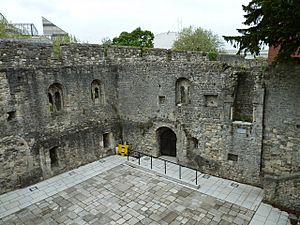King John's Palace, Southampton facts for kids
Quick facts for kids King John's Palace |
|
|---|---|
 |
|
| Type | Ruined Norman merchant's house |
| Location | Blue Anchor Lane, Southampton City Centre |
| OS grid reference | SU4182211285 |
| Elevation | 6 metres (20 ft) |
| Height | 2 floors |
| Built | 1170s–1180s |
| Reference no. | 1001887 |
|
Listed Building – Grade I
|
|
| Designated | 14 July 1953 |
| Reference no. | 1339942 |
| Lua error in Module:Location_map at line 420: attempt to index field 'wikibase' (a nil value). | |
King John's Palace is an old house in Southampton, England. It is now mostly a ruin. For a long time, people thought King John lived here, which is how it got its name. But this was a mistake!
The house's west wall became part of the city's defenses in the early 1300s. Its archways might even have Britain's oldest surviving gunports. Today, this historic building is part of the Tudor House Museum in Southampton. It is also a protected ancient monument.
Contents
Its Story Through Time
This house was built a very long time ago, either in the 1170s or 1180s. It stood right by the quayside, which means it had direct access to the town's West Quay. This was perfect for a merchant.
In the early 1300s, a rich merchant named John Wytegod owned the house. He was even the Mayor of Southampton! The street next to the house, now called Blue Anchor Lane, was once known as Wytegod's Lane after him.
In 1338, French raiders attacked Southampton. The town was not well protected. After this attack, King Edward III ordered that Southampton's sea defenses be made much stronger. Because of this, the house became part of the town's defensive wall. The doors and windows facing the quay were blocked up or turned into narrow slits for defense.
Later, in the early 1700s, the building was used as a coach house and stables. In the early 1800s, a coal merchant used it for his business. At the start of the 1900s, a man named Mr. Spranger had a private museum inside. The roof was taken off in the early 1900s, leaving the building as a shell, which is how it looks today.
People used to believe that King John lived in the building in the early 1200s. This is why it got the name "King John's Palace." However, historians now know that King John never actually lived there.
What It Looks Like
The house had two floors. The living areas were on the top floor. This floor had large windows and a fireplace to keep it warm.
Inside the House
On the ground floor, people stored large barrels of wine. This wine was brought in from France. The windows on this floor were made very small on purpose. This was to stop thieves from breaking in and stealing the valuable wine. The whole building is made of strong stone.
Walls and Windows
You can still see the original windows from the 1100s on the north and west sides of the building. They have a round shape at the top and sit within round-arched frames. There are two windows on each side.
The west wall of the house has three archways that once led to the quays. One of these is an original round-headed arch. The other two are segmental-headed arches, added in the early 1300s. These archways are now blocked up. Inside these arches, you can see two vertical slits. These were part of the 14th-century defenses. They might be the oldest surviving gunports in Britain!
Fireplace and Chimney
The fireplace for the first floor was on the north side of the house. Parts of the fireplace are still there, including its side supports, called jambs. These jambs have special carved tops, known as scalloped capitals, and small columns inside them.
A chimney that was built around 1200 was moved from another building in Southampton, at 79A High Street. It is now placed against the east wall of King John's Palace. This chimney has a square base but a long, round shaft.

